Can Fleas Live in Human Hair? The Truth Revealed
Ever wondered if fleas could jump from your pet to your head? Many pet owners and parents ask: can fleas live in human hair? Imagine feeling an itch on your scalp that’s not just dryness or dandruff. Could it be a human flea infestation? Let’s look into the facts and clear up myths about fleas on humans.
This part of our article starts an interesting journey into fleas and humans. We’ll see why pets are a feast for fleas, but humans are just a snack. Stay with us to learn the surprising facts about where fleas can and can’t live.
Table of Contents
Understanding Fleas and Their Host Preferences
Managing fleas requires knowing about flea species and their hosts. Fleas are not just pests; they have specific preferences and behaviors. This knowledge is key, especially for pet owners, as fleas on pets are a big worry.
Flea Species and Their Natural Hosts
There are many flea species, each with its own host preference. The cat flea, for example, likes both cats and dogs, despite its name. Other fleas, like the dog flea, stick to dogs. Knowing which flea species you have helps in fighting infestations and keeping pets safe.
Fleas are not just itchy; they’re dangerous to their hosts. These hosts, like raccoons and rodents, carry many flea species. Fleas live in these natural settings, jumping from host to host and spreading their lifecycle.
Why Pets Are More Susceptible to Fleas Than Humans
Pets are more likely to get fleas because of their lifestyle. They spend more time outside, where fleas are common. Their warm fur also makes a great home for fleas.
Knowing this helps in treating and preventing flea problems. Regular grooming and vet visits are important. They help catch and manage fleas before they become a big problem.
Can Fleas Live in Human Hair: Separating Myth from Reality
When we talk about fleas on humans, it’s key to know what’s true and what’s not. Many ask if fleas can live in human hair. Let’s look at the science and clear up some common myths about human flea infestation.
Fleas usually live on furry animals. Human hair doesn’t have the same density or oils as animal fur. So, it’s not the best place for fleas. But, fleas can still land on humans, even if it’s not their favorite spot.
Experts agree that while fleas might not choose to live on humans, they can still bite and latch onto human skin if exposed during contact with infested animals or environments.
Knowing how fleas work helps us see why they don’t like human hair. Here are some facts to help understand this better:
| Flea Characteristic | Preference for Animals | Implication for Humans |
|---|---|---|
| Body Structure | Adapted to navigate through thick fur | Less effective in sparse human hair |
| Feeding Needs | Requires blood meals from specific hosts | Humans are not a natural or preferred host |
| Reproductive Habits | Fleas lay eggs in animal fur that provides camouflage | Human hair does not offer the security or environment fleas seek for egg laying |
In short, while fleas on humans can happen, human hair isn’t a great place for them. Knowing this helps us understand why human flea infestations are rare. The best way to avoid fleas is through prevention, being aware, and taking care of your pets.https://www.naturalpurecare.com/natural-care-flea-and-tick-spray-effects
The Lifecycle of a Flea: How It Affects Their Habitats
Learning about the flea lifecycle helps us see why some places get infested more. Each flea stage affects how they live in their environment. This shapes their survival and ability to grow in different settings.
Stages of Flea Development
Fleas go through four main stages: egg, larva, pupa, and adult. The place they pick for each stage is key to their survival and growth.
- Eggs: Female fleas lay them in warm, moist spots.
- Larvae: They stay away from light and eat organic stuff around them.
- Pupae: They hide in cocoons, waiting for the right time to come out.
- Adults: They look for hosts like pets or wild animals. But they can also live without food for a while.
Survival Tactics of Fleas Outside The Host
Fleas have special ways to survive outside a host. These tricks help them live in different flea habitats. This keeps the infestation cycle going.
- Humidity Resistance: Larvae need high humidity to live, so they pick certain places.
- Temperature Sensitivity: Fleas do best in warm places, making homes more at risk.
- Feeding Patterns: Adult fleas can go a long time without eating. This lets them wait for the best time to feed.
Understanding the flea lifecycle helps us fight these pests better. Whether they’re in your carpet or hiding in human hair, knowing their habits helps prevent and treat infestations.
Human Flea Infestation: Recognizing the Signs
Wondering if you have human flea bites or an infestation? Knowing what to look for is key. Spotting flea evidence in your space is the first step to take action. Here’s how to spot signs of a human flea infestation.
Identifying Flea Bites on Humans
Flea bites are small, red, and itchy. They often show up on the feet, ankles, and legs. But they can pop up anywhere on your body.
Look for multiple bites in clusters or lines. This is a clear sign of an infestation. If you see such patterns, check your living space for more flea signs.
Physical Evidence of Fleas in Your Hair
Finding fleas in your hair can be shocking. They are small, dark, and quick. You might feel a tickling or see tiny black specks on your scalp.
Use a fine-toothed comb over a white sheet to find them. This method can help detect fleas if they’re there.
Regular checks and cleaning are vital to keep your space flea-free. If you think you have fleas, act fast. This will help reduce discomfort and stop the infestation from spreading.
Getting Rid of Fleas in Hair: Proven Methods and Precautions
Fleas in human hair can be a real nuisance. If you’re dealing with getting rid of fleas in hair, it’s key to act fast. We’ll look at effective flea treatment for humans and how to keep your hair flea-free.
Fleas can thrive in human hair through contact with infested pets or environments. Ensure comprehensive treatment to prevent their return.
Initial Steps for Removal:
- Start by washing your hair with flea control shampoo designed for humans.
- Comb through wet hair with a fine-toothed flea comb to remove any fleas and their eggs.
- Apply a natural oil like coconut or olive oil which can suffocate fleas still lurking.
Maintaining a Flea-Free Scalp:
- Regularly wash your bedding, hats, and hair accessories at high temperatures to kill fleas.
- Vacuum carpets and furniture frequently to capture fleas from the environment.
When looking at over-the-counter options or home remedies, make sure they’re safe for human skin and hair. Below is a table of common treatments.
| Type of Treatment | Description | Precautions |
|---|---|---|
| Medicated Shampoos | Contain ingredients to kill fleas actively. | Use only formulations safe for humans, avoid pet shampoos. |
| Herbal Remedies | Uses natural ingredients like tea tree or neem oil. | Perform a patch test to check for skin reactions. |
| Flea Combs | Manual removal of fleas using a specially designed comb. | Requires thorough combing in sections, may be time-consuming. |
To fight flea infestations, consistent treatment and keeping your environment clean are key. By following these steps, you can keep your hair and home flea-free.
Professional Flea Treatment for Humans: When to Seek Help?
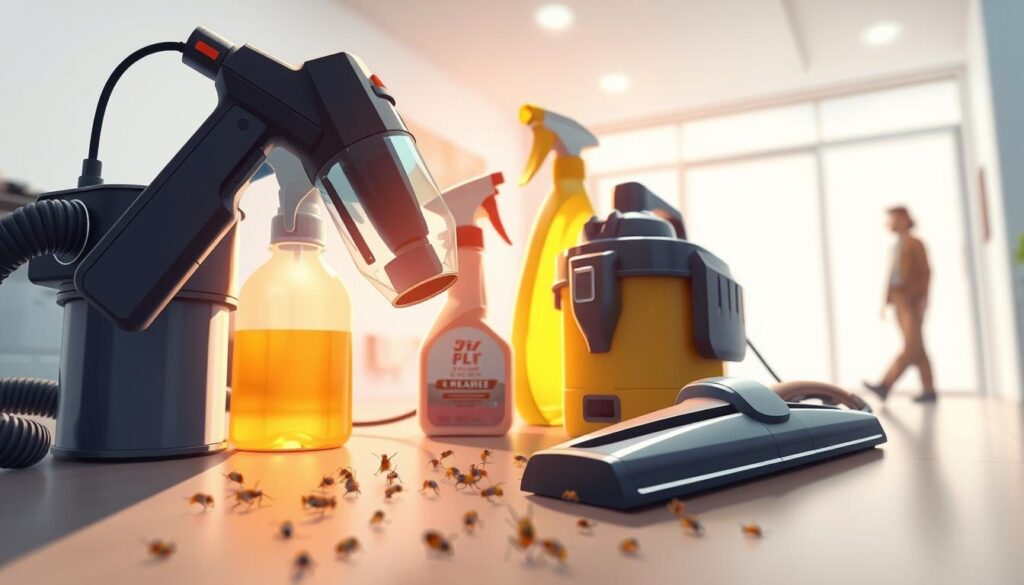
Dealing with fleas can be really tough and uncomfortable. Many over-the-counter options are out there, but some situations need professional help. Knowing when to see a dermatologist or pest control can save you time and get better results.
Navigating Through Over-the-Counter Solutions
Many over-the-counter flea treatments give temporary relief. But, they work better as preventives than for severe infestations. If you’ve tried sprays, shampoos, and more without success, it’s time for professional help.
Consulting a Dermatologist or Pest Control Expert
If fleas keep coming back or your skin reacts badly, see a dermatologist. They can give you skin treatments and advice to ease discomfort. Also, a pest control expert can tackle the infestation with stronger methods than over-the-counter options.
Remember, professional flea treatment is about your health, not just getting rid of pests. If the problem is big or keeps coming back, getting expert help is best. A dermatologist or pest control expert can stop the problem from getting worse. They offer a safe, effective way to take back your space and peace of mind.
Do Fleas Bite Humans? Understanding Your Risk
Ever wondered if fleas bite humans? Many think fleas only go for pets, but they can bite us too. This can lead to health problems.
Differentiating Between Flea and Other Insect Bites
Flea bites are small, red, and often in groups. They usually show up on your feet, ankles, and legs. Unlike mosquito bites, flea bites follow a pattern and itch a lot.
Health Risks Associated with Human Flea Bites
Flea bites can be more than just annoying. They can spread diseases like plague and typhus. Scratching them too much can also cause skin infections.
Here’s a quick comparison:
| Insect Type | Common Symptoms | Disease Risk |
|---|---|---|
| Fleas | Small, red, clustered bites; intense itching | High (plague, typhus) |
| Mosquitoes | Large, diffuse, red welts; moderate itching | Variable (malaria, West Nile virus) |
| Bed Bugs | Small, red, linear bites; severe itching | Low (no known disease transmission) |
Knowing about flea bites can help protect you. It’s important to recognize their signs to prevent and treat them.
Preventing Fleas in Hair: Effective Strategies for Flea Control
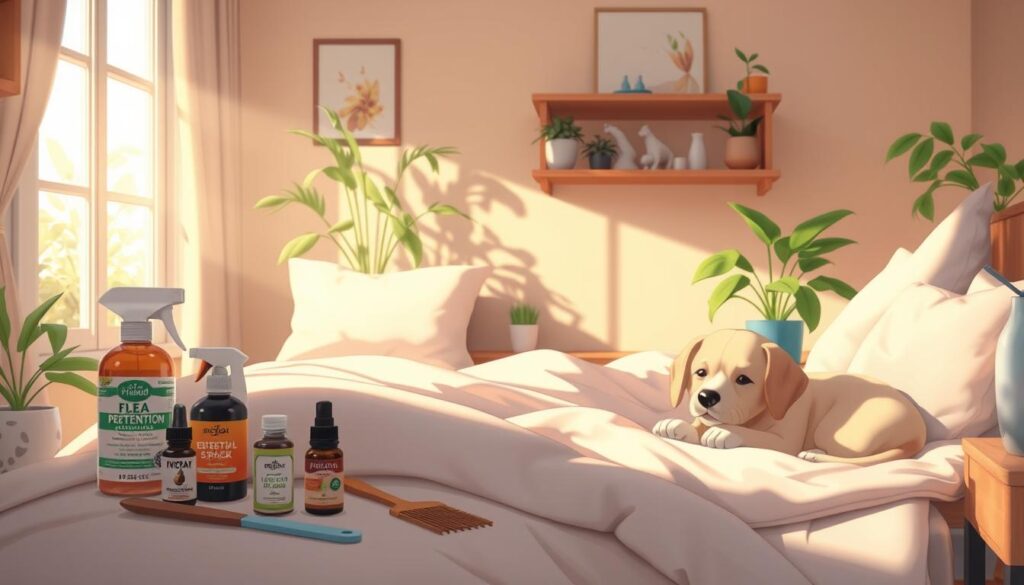
Keeping your hair flea-free is a big part of personal care. Fleas can cause itching and discomfort. To avoid this, it’s important to use flea prevention strategies. Here are some easy tips to keep your hair flea-free every day.
- Maintain Good Hygiene: Washing your hair and body regularly helps prevent fleas.
- Use Flea Repellent Hair Products: There are shampoos and conditioners that keep fleas away. They have ingredients fleas don’t like.
- Regular Home Cleaning: Vacuuming and cleaning beddings where fleas hide is key. Fleas can jump from pets to your hair, so keep their sleeping areas clean.
- Avoid Wildlife Areas: Places with lots of wildlife have fleas. Stay away from grassy patches and bushy areas to lower your risk.
For more detailed advice, check out the table below. It shows practical flea prevention strategies for different places:
| Environment | Action | Product/Method |
|---|---|---|
| Home | Clean Regularly | Vacuum, Wash Beddings |
| Personal Care | Use Preventative Shampoos | Flea Repellent Hair Products |
| Outdoor Activities | Avoid Flea-Prone Areas | Protective Clothing, Insect Repellent Sprays |
| Pet Care | Maintain Pet Hygiene | Regular Grooming, Flea Treatments |
Knowing and using these flea prevention strategies helps keep fleas away from your hair. It also improves your overall health. The secret to controlling fleas is being consistent and using a mix of methods that fit your life and surroundings.
Natural and Chemical-Free Solutions for Removing Fleas
Looking for ways to keep your home flea-free? Choosing natural and chemical-free options is safe and good for the planet. Brands like NaturalPureCare have created effective formulas that fight fleas without harsh chemicals.https://www.amazon.com/flea-treatment/s?k=flea+treatment
Home Remedies and NaturalPureCare for Flea Removal
Trying home remedies for flea control can be fun and effective. Items like lemon juice and apple cider vinegar can repel fleas naturally. Mixing these with NaturalPureCare products makes your flea treatment safer and more effective.
The Role of Preventative Naturalcare in Flea Treatment
Preventing fleas is key to avoiding future problems. Regularly clean your bedding and use eco-friendly flea traps. Natural deterrents like eucalyptus or lavender oil can also help keep fleas away.
| Natural Ingredient | Effectiveness | Usage Tips |
|---|---|---|
| Lemon Juice | High | Apply directly to affected areas |
| Apple Cider Vinegar | Moderate | Dilute with water and spray onto pet fur |
| Eucalyptus Oil | High | Place leaves under pet bedding |
| Lavender Oil | Good | Use in a diffuser for ongoing prevention |
Can Fleas Live in Human Hair?
Fleas are commonly associated with pets, particularly cats and dogs. While human flea infestations are rare, it’s possible for fleas, including cat fleas, to bite humans and temporarily live in human hair. Fleas feed on blood meals from their hosts, and their bites can cause discomfort and itching. These pests are known for laying their eggs in pet fur, which can then spread into carpets, bedding, and even human hair in some cases. Although fleas themselves do not typically live in human hair for long periods, their bites can lead to itching, and scratching could introduce bacteria, which may cause infections.
Fleas are more than just a nuisance; they are also carriers of harmful diseases. One of the most notorious diseases transmitted by fleas is the bubonic plague, historically associated with outbreaks that had devastating consequences. Fleas are capable of transmitting bacteria such as Yersinia pestis, which causes this life-threatening disease. Though the risk of contracting the bubonic plague from fleas in your hair is extremely low today, it’s still important to manage flea infestations promptly to avoid any health risks.
Conclusion
We’ve looked into whether fleas can live in human hair and found important facts. Now, you know how to spot flea infestations and act fast. Getting rid of fleas means understanding their life cycle and how to stop it.
Choosing the right treatment is key. You can use natural methods or professional help. The way you handle fleas can greatly impact your success.
Preventing flea infestations requires constant watchfulness and quick action. You can use store-bought products or seek expert advice. Natural treatments are a good choice for those who prefer not to use chemicals.
These methods can help keep your home safe from fleas. Remember, prevention is the best defense.
To keep your home flea-free, you need to stay alert and proactive. Use the tips we’ve shared to protect yourself and your pets. With the right information and effort, you can keep your home comfortable and free from fleas.

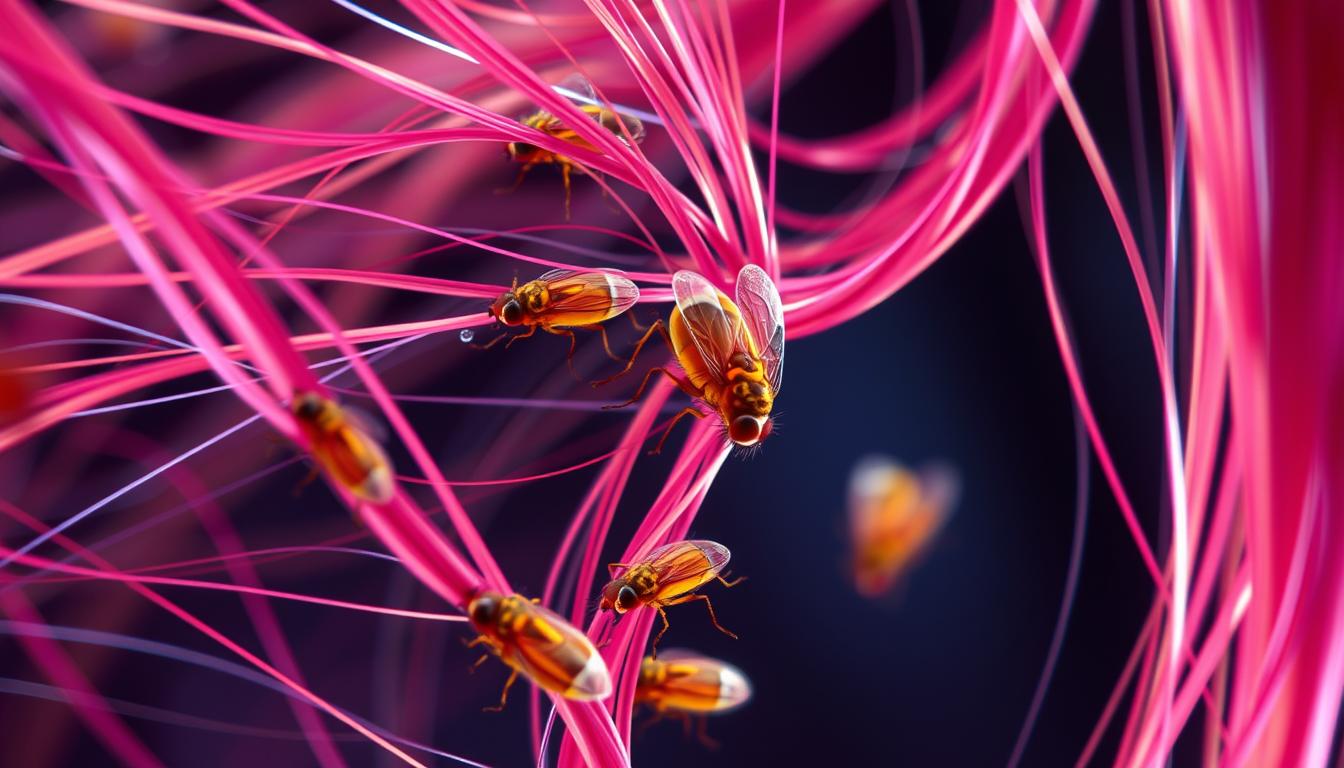
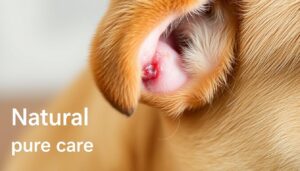


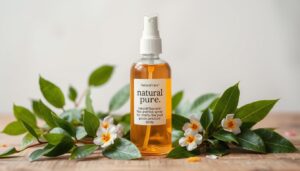

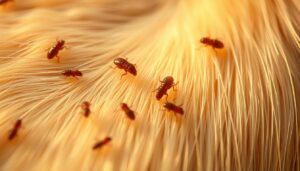
One Comment
Comments are closed.